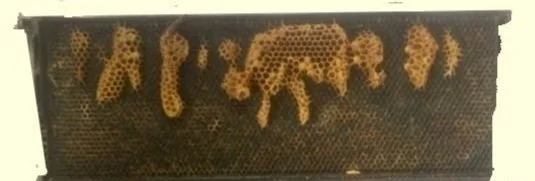
Cleaning Frames
Soaking and blasting
Brood frames become darker with age and may harbour disease. Given this, the comb should be replaced every three years. When removing the old frames, consider whether they contain honey the bees could draw down. Re-using plastic frames is less involved than for wooden ones.
Reusing plastic frames is straightforward
Remove the gunky comb off the frames with a scraper, pressure washer is easier. Alternatively, put the combs in a warm dark place so that wax moths do the job for you.
Soak in a mixture of washing soda, detergent and bleach for about a week. I am experimenting with omitting this stage.
Pressure wash
1. Scraping
Scraping is onerous, but enables you to keep the dirty wax. Pressure hosing is so much easier, and anyway, it is hard labour extracting a little wax from loads of old comb. To scrape, use a plastic kitchen implement, wallpaper removing tool, or whatever works for you. I never scrape now; when I did, I used a blunt chisel and caused a little damage to the foundation. Dark comb is often packed with pollen, so try to avoid removing these frames in the autumn, which is impracticable and a nice idea. Chilling makes wax brittle and stores like toffee.
Some people use a steel brush to remove more muck; I find it a waste of time.
Damage caused by vigorous scraping
Wax and crud from 30 frames fill a GBpro container. Most people find recovering clean wax by rendering too boring and throw the crud away. Other people soak it in hot water and squeeze wax out through a sieve. I gather it is quite successful. If you take lumps of this part rendered wax to a trade convention, some equipment retailers will exchange it for fresh foundation. The final photo shows how wax moths do a terrific job.
1b. Pressure washing
To prevent the frames from flying all over the place, put them on something like an off-cut of artificial grass, or just be careful to direct the jet perpendicular to the ground.
2. Soaking
Soaking/cleaning tank
Warped frame
GBpro mop buckets fit medium frames perfectly
Use soda crystals diluted 1:5. Leave the frames for a long time. One day makes little difference. Seven days are adequate for most frames. Someone on YouTube advocates six weeks, but he only scraped before soaking. A generous squirt of washing up liquid is helpful. One manufacture claims that the frames can be hot washed. I tried doing this and destroyed a pile of frames.
Pressure washing alone without soaking is almost as good, so I’m trying that.
3. Pressure Washing
A stubborn frame can take five minutes with a 130 bar washer since it necessitates placing the tip of the pressure washer gun directly on the foundation and moving it back and forth like erasing pencil marks. Some frames take less than a minute. If you want to be speedy, buy a 170 bar washer. One that pumps at that pressure continuously. Your patio deserves it.
Pressure washers: 110 and 170 bar. The larger one blasts old wax off the frames so effectively that scraping is unnecessary, unless you or your bees are fussy.
Let the bees clean them
This is what Bee-equipment.co.uk recommends:
“After two seasons, use a wide scraper to clean the plastic foundation back to the rib, then place the box and frames back on the hive above a crown board with just one hole open. The bees usually clean the residue from the plastic frames, leaving the plastic foundation ready to use. If you think the frames need a more thorough cleaning, you can do it with a small steam cleaner or soaking them in soda and bleach”.
Frames from which the bees partially removed the residue (visible in the upper area of the frame). However, since this left the surface devoid of wax, they made rubbish comb.
Mouldy frames
If the frame does not smell of alcohol, expose it for a few days so it dries out, and then put it in a hive for the bees to clear. But be cautious; recycle the frame if it has the slightest whiff of fermentation. Chalkbrood and pollen can look mouldy. Pollen is friable.
Wooden frames
There are two methods, depending on whether the bottom bar is slotted or not.
Frames with a slotted bottom bar
Heat a drum of washing soda solution.
Punch or gently pressure wash the comb out of the frames.
Scrape to remove wax and propolis.
Tie some frames together and submerge them in the hot solution.
Rinse.
Tease the frames apart and remove the tangle of wires.
Assemble the frames and insert fresh foundation.
Frames with a solid bottom bar
Remove the comb and gently pressure wash so as not to damage the wood.
Soak in cold or hot washing soda solution - it depends how clean you want them to be.
Pressure wash
Soak in cold water
Dry
Tighten the wires imbed foundation before use.
Storing combs
The chief threats are mice and wax moth so be sensible.
Page F3

















